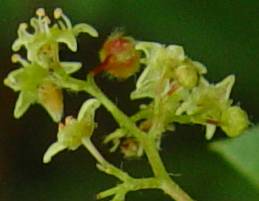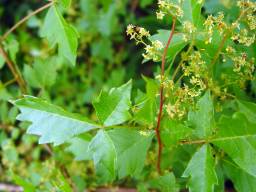Searsia dentata
Searsia dentata (Thunb.) F.A. Barkley
Family: Anacardiaceae
Common names: nana-berry ( Eng. ); nanabessie (Afr.); inKlolo (Xhosa); Lebelebele (Sotho); Umkungu (Ndebele)
SA Tree No: 381
Introduction
The nana-berry, Searsia dentata, is an attractive shrub indigenous to South Africa with showy, lovely yellow to orange-red foliage in autumn. It is a common shrub across the eastern parts of South Africa. Along with several other species in this genus, it could be is used more commonly in gardens.

Description
Description
Searsia dentata is a deciduous shrub to small tree up to 6 m high, with a smooth, greyish brown bark. The leaves, which are pink when young, turning dull yellow to orange-red in autumn, are trifoliolate, with the two side leaflets smaller than the terminal leaflet, dark green above and paler green below with long hairs; the leaflets are sessile on a slender petiole.

The small, yellowish green flowers are borne in clusters at the end of the branches from September to November, and this species has male and female flowers on different plants. The flowers are followed by the shiny, bright red fruits, in heavy clusters from November to January on the female plants. This species is often confused with Searsia montana which shares the same habitat.
Distribution and habitat
Distribution description
This widespread species is common in rocky ravines, thornveld, open woodland and bushveld, at the margins of forest, along watercourses, over the eastern part of South Africa in Limpopo, Gauteng , Mpumalanga, the Free State, KwaZulu-Natal, the Eastern Cape, the Western Cape as well as some parts of Swaziland and Lesotho.
Derivation of name and historical aspects
History
Searsia was named after Paul B. Sears (1891-1990) who was head of the Yale School of Botany and dentata is derived from Latin meaning deeply toothed. Most of the species grown in southern Africa, belonging to the genus Rhus, have been placed in Searsia. In southern Africa there are about 91 taxa in the genus. They are deciduous or evergreen shrubs and trees, sometimes armed, and stems and branches have prominent lenticels. Leaves of this genus are compound with three leaflets (trifoliolate).

Ecology
Ecology
Bees and other insects pollinate the flowers. Birds eat the ripe fruits. S. dentata can withstand harsh environmental conditions such as drought and frost.
Uses
Use
The nana berry makes an interesting focal point in the garden; the flowers attract butterflies and the attractive fruit brings a host of birds and insects to visit. In autumn the ornamental leaves change colour, making this a multi-season garden plant.
Growing Searsia dentata
Grow
This species grows in almost any kind of soil. Young plants need lots of water but once they are established, they do not need much. These plants are therefore good subjects for water-wise gardening. This shrub does well in a cool soil, with a thick layer of leaf mould (natural organic matter) on top.
Species of Searsia are easily propagated from seed and air-layering and S. dentata can also be easily grown from cuttings. Sow seed in trays and, if available use subsurface heating or a mist unit , to provide a constant temperature of 20-25 ° C to speed up the germination of seed . See Searsia discolor for the standard propagation medium used for Searsia species in general. Sow fresh seeds for successful germination.
Searsia dentata grows rapidly, up to 0.5 m a year. It prefers sun or semi-shade. Prune to remove dead branches and to shape it. It can be used as a hedge plant and forms akes a very strong barrier if planted closely. It is frost and drought hardy and makes a beautiful container plant.
Other species of Searsia worth cultivating include:
References
- Acocks, J.P.H. 1988. Veld types of South Africa, edn 3. Memoirs of the Botanical Survey of South Africa No. 57. Botanical Research Institute, Pretoria.
- Carr, J.D. 1994. The propagation and cultivation of indigenous trees and shrubs on the highveld . Sandton Nature Conservation Society and the Tree Society of Southern Africa, Johannesburg .
- Coates Palgrave, K. 1981. Trees of southern Africa , edn 2. Struik, Cape Town.
- Joffe, P. 1993. The gardener's guide to South African plants . Delos, Cape Town.
- Joffe, P. 2003. Creative gardening with indigenous plants . Briza Publications, Pretoria .
- Moffett, R.O. 1993. Anacardiaceae: Rhus . Flora of southern Africa 19, Part 3, Fascicle 1. National Botanical Institute, Pretoria.
- Moffett, R.O. 2007. Name changes in the Old World Rhus and recognition of Searsia (Anacardiaceae). Bothalia 37(2):165-175
- Palmer, E. 1977. A field guide to the trees of southern Africa . Collins, London.
- Van Wyk, B. & Van Wyk, P. 1997. Field guide to trees of southern Africa . Struik, Cape Town.
- Venter, H.J.T. 1976. Trees and shrubs of the Orange Free State . De Villiers, Bloemfontein.
Credits
Mashudu Peter Gavhi
Free State NBG
September 2005
Updated July 2008
Plant Attributes:
Plant Type: Shrub
SA Distribution: Eastern Cape, Free State, Gauteng, KwaZulu-Natal, Limpopo, Mpumalanga, Western Cape
Soil type:
Flowering season: Spring
PH:
Flower colour: Green, Cream
Aspect: Full Sun
Gardening skill: Easy
Special Features:
Horticultural zones











Rate this article
Article well written and informative
Rate this plant
Is this an interesting plant?
Login to add your Comment
Back to topNot registered yet? Click here to register.